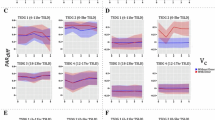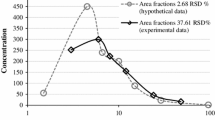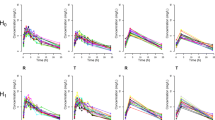Abstract
Purpose. The objective of this work was to develop and validate blood sampling schemes for accurate AUC determination from a few samples (sparse sampling). This will enable AUC determination directly in toxicology studies, without the need to utilize a large number of animals.
Methods. Sparse sampling schemes were developed using plasma concentration-time (Cp-t) data in rats from toxicokinetic (TK) studies with the antiepileptic felbamate (F) and the antihistamine loratadine (L); Cp-t data at 13–16 time-points (N = 4 or 5 rats/time-point) were available for F, L and its active circulating metabolite descarboethoxyloratadine (DCL). AUCs were determined using the full profile and from 5 investigator designated time-points termed “critical” time-points. Using the bootstrap (re-sampling) technique, 1000 AUCs were computed by sampling (N = 2 rats/point, with replacement) from the 4 or 5 rats at each “critical” point. The data were subsequently modeled using PCNONLIN, and the parameters (ka, ke, and Vd) were perturbed by different degrees to simulate pharmacokinetic (PK) changes that may occur during a toxicology study due to enzyme induction/inhibition, etc. Finally, Monte Carlo simulations were performed with random noise (10 to 40%) applied to Cp-t and/or PK parameters to examine its impact on AUCs from sparse sampling.
Results. The 5 time-points with 2 rats/point accurately and precisely estimated the AUC for F, L and DCL; the deviation from the full profile was ~10%, with a precision (%CV) of ~15%. Further, altered kinetics and random noise had minimal impact on AUCs from sparse sampling.
Conclusions. Sparse sampling can accurately estimate AUCs and can be implemented in rodent toxicology studies to significantly reduce the number of animals for TK evaluations. The same principle is applicable to sparse sampling designs in other species used in safety assessments.
Similar content being viewed by others
REFERENCES
J. Heykants and W. Meuldermans. Nonclinical kinetics and metabolism studies in the safety assessment of drugs. Drug Information Journal, 28:163–172 (1994).
M. N. Cayen. Considerations in the design of toxicokinetic studies. Toxicologic Pathology, 23:148–157 (1995).
ICH/EFPIA Safety Task Force on Toxicokinetics. Note for Guidance on Toxicokinetics. Draft No. 7 (1992).
Unpublished data on file. Department of Drug Metabolism and Pharmacokinetics. Schering-Plough Research Institute, Kenilworth, NJ.
Unpublished data on file. Department of Drug Metabolism and Pharmacokinetics. Schering-Plough Research Institute, Kenilworth, NJ.
J. Hempenius, G. Hendriks, J. Hingstman, C. K. Mensink, J. H. G. Jonkman, and C. C. Lin. An automated analytical method for the determination of felbamate in human plasma by robotic sample preparation and reversed-phase high performance liquid chromatography. J. Pharm. Biomed. Anal. 12 (1994).
R. Johnson, J. Christensen, and C. C. Lin. Sensitive gas-liquid chromatographic method for the determination of loratadine and its major active metabolite, descarboethoxyloratadine in human plasma using a nitrogen-phosphorus (N/P) detector. J. Chromatogr. B. 657:125–131 (1994).
M. Gibaldi and D. Perrier. Pharmacokinetics, 2nd edition, Marcel Dekker, New York, 1982, pp. 409–417, 445–449.
PCNONLIN, Version 4.0. Statistical Consultants Inc. Lexington, KY (1992).
A. Akaike. Posterior probabilities for choosing a regression model, Annals of the Institute of Mathematical Statistics, 30(A):9–14 (1978).
SAS. Statistical Institute Inc., Cary, NC. SAS Language: Reference, version 6, 1st edition, pp. 589 (1990).
H. Boxenbaum and M. Battle. Effective half-life in clinical pharmacology. J. Clin. Pharmacol. 35:763–766 (1995).
M. Gibaldi and D. Perrier. Pharmacokinetics, 2nd Edition, Marcel Dekker, New York, 1982, pp. 451–457.
B. Efron and R. J. Tibshirani. An Introduction to the Bootstrap. Chapman & Hall, New York, 1993.
H. Mager and G. Göller. Analysis of pseudo-profiles in organ pharmacokinetics and toxicokinetics. Statistics in Medicine. 14:1009–1024 (1995).
T. M. Ludden. Population pharmacokinetics. J. Clin. Pharmacol. 28:1059–1063 (1988).
B. Whiting, A. W. Kelman, and J. Grevel. Population pharmacokinetics: Theory and clinical applications. Clin. Pharmacokinet. 11:387–401 (1986).
F. Mentre, P. Burtin, Y. Merle, J. V. Bree, A. Mallet, and J-L. Steimer. Sparse-sampling optimal designs in pharmacokinetics and toxicokinetics. Drug Information Journal, 29:997–1019 (1995).
J. V. Bree, J. Nedelman, J-L. Steimer, F. Tse, W. Robinson, and W. Niederberger. Application of sparse sampling approaches in rodent toxicokinetics: A prospective view. Drug Information Journal, 28:263–279 (1994).
Author information
Authors and Affiliations
Rights and permissions
About this article
Cite this article
Pai, S.M., Fettner, S.H., Hajian, G. et al. Characterization of AUCs from Sparsely Sampled Populations in Toxicology Studies. Pharm Res 13, 1283–1290 (1996). https://doi.org/10.1023/A:1016097227603
Issue Date:
DOI: https://doi.org/10.1023/A:1016097227603




